Sedimentary and Early Diagenetic Responses to the Huaiyuan Movement During the Early–Middle Ordovician Transition in the Ordos Basin, North China
Abstract
1. Introduction
2. Geological Setting
3. Materials and Methods
3.1. Sample Preparation
3.2. Major, Trace, and Rare Earth Elements Analyses
3.2.1. Carbonate Component Analysis
3.2.2. Siliceous Component Analysis
3.3. Carbon and Oxygen Isotope Analyses
4. Results
4.1. Petrological Characteristics
4.2. Geochemical Characteristics of Carbonate Components
4.2.1. Major and Trace Elements
4.2.2. Carbon and Oxygen Isotopes
4.2.3. Rare Earth Elements of Carbonate Components
4.3. Geochemical Characteristics of Siliceous Components
4.3.1. Major and Trace Elements and Ge/Si Ratio
4.3.2. Rare Earth Elements of Siliceous Components
5. Discussion
5.1. Evolution of Sedimentary Environments
5.2. Characteristics of Early Diagenesis
5.2.1. Siliceous Cementation
Source of Silica
- (1)
- Identification of silica source
- (2)
- Origin of biogenic silica
Siliceous Cementation Process
5.2.2. Dolomitization
5.3. The Responses of Sedimentation and Early Diagenesis to the Huaiyuan Movement at the Turn of the Early–Middle Ordovician
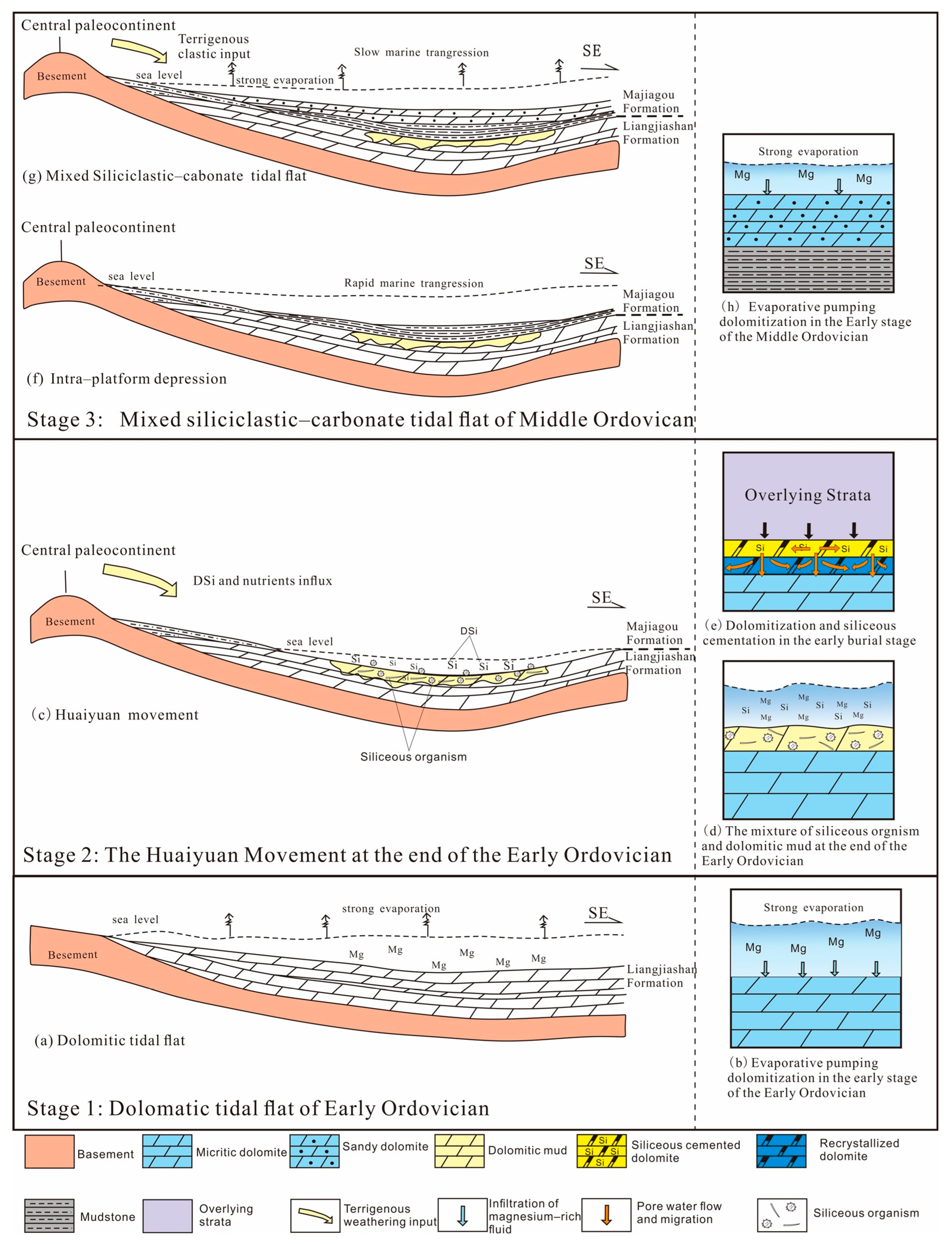
6. Conclusions
Author Contributions
Funding
Data Availability Statement
Acknowledgments
Conflicts of Interest
References
- Lin, Y.X.; Zhao, C.J.; Zhu, C.Z.; Luan, W.N.; Wu, Y.C.; Li, J.; Li, X.Q. Lithofacies Paleogeography Characteristics of Early Ordovician in the Eastern Part of North China Platform. J. Earth Sci. Environ. 2015, 37, 1–9, (In Chinese with English Abstract). [Google Scholar]
- Song, D.N. Re-Recognition of Huaiyuan Movement. Shandong Geol. 2001, 17, 19–23, (In Chinese with English Abstract). [Google Scholar]
- Liu, B.; Wang, Y.H.; Qian, X.L. The Two Ordovician Unconformities in China: Their Origins and Related Regional Reservoirs′ Prediction. Acta Sedimentol. Sin. 1997, 15, 25–30, (In Chinese with English Abstract). [Google Scholar]
- Han, Z.; He, J.Y.; Wang, Y.H.; Yu, S.Y. Sedimentary Facies and Sequence Stratigraphy of Lower Paleozoic in North China. Earth Sci.—J. China Univ. Geosci. 1997, 22, 293–299, (In Chinese with English Abstract). [Google Scholar]
- Liu, H.Q.; Li, X.B.; Ma, Y.H.; Bai, Y.L.; Huang, J.P. The unconformity caused by the Huaiyuan movement and the deep natural gas exploration field in the Ordos Basin. Nat. Gas Ind. 2021, 41, 1–12, (In Chinese with English Abstract). [Google Scholar] [CrossRef]
- Li, X.B.; Wang, H.B.; Huang, J.P.; Zhang, C.L.; Zhang, Y.; Wang, Y.T.; Zhang, L.; Wang, Q.; Liu, H.Q. Characteristics of unconformity resulted from Huaiyuan Movement in Ordos Basin and its significance for oil and gas exploration. Oil Gas Geol. 2021, 42, 1043–1055, (In Chinese with English Abstract). [Google Scholar]
- Ma, M. Early Paleozoic Tectonic Evolution of the Ordos Basin and Geodynamics. Ph.D. Thesis, Northwest University, Xi’an, China, 2020. (In Chinese with English Abstract). [Google Scholar]
- Wang, F.; Chen, H.D.; Zhao, J.X.; Chen, A.Q.; Su, Z.T.; Li, J. Sequence boundary and petroleum geology of the Cambrian–Permian strata in the Ordos Basin. Sediment. Geol. Tethyan Geol. 2011, 31, 6–12, (In Chinese with English Abstract). [Google Scholar]
- Mao, D.F.; He, D.F.; Bao, H.P.; Wei, L.B.; Xu, Y.H.; Cheng, X.; Gou, J.Y.; Wu, S.J. Distribution, evolution and structural 7properties of Wushenqi paleo-uplift in Ordos Basin. Pet. Explor. Dev. 2023, 50, 755–766, (In Chinese with English Abstract). [Google Scholar] [CrossRef]
- Han, X.Y.; Zhang, C.G.; Jing, X.H.; Fu, S.Y.; Su, Z.T.; Liu, Z.M. Tectonic sedimentary response and genetic evolution characteristics of the unconformity surface at the bottom of the Majiagou Formation in the Ordos Basin. J. Chengdu Univ. Technol. 2024, 51, 709–726, (In Chinese with English Abstract). [Google Scholar]
- Zhang, J.T.; Zhang, Y.Y.; Gu, N.; Jin, X.H.; Zhang, T.; Liu, S.H.; Jia, H.C.; Yang, J.Q.; Liu, L.; Gao, X.P. Unconformity characteristics of Huaiyuan movement in the northeast of Wushenqi paleo-uplift in Ordos Basin and its implications for karst reservoir generation. Oil Gas Geol. 2023, 44, 101–109, (In Chinese with English Abstract). [Google Scholar]
- Chen, Q.L.; Bai, Y.L.; Ma, Y.H.; Liu, X.G. Further Study on Lithofacies Palaeogeography and Sedimentary-Tectonic Evolution of Cambrian in Ordos Basin, North China. J. Jilin Univ. Earth Sci. Ed. 2013, 43, 1697–1715, (In Chinese with English Abstract). [Google Scholar]
- He, D.F.; Shao, D.B.; Cui, Y.P.; Bao, H.P.; Kai, B.Z.; Fu, D.W.; Cao, Y.G. Delineation, formation, and geological significance of Majiatan paleo-plant at the western margin of Ordos Basin. Acta Pet. Sin. 2018, 39, 609–619, (In Chinese with English Abstract). [Google Scholar]
- Yuan, L.P.; Zhou, H.R.; Jing, X.C.; Wang, Z.T.; Chuan, T.T.; Fang, Q. Microfacies and facies analysis of the Ordovician carbonates in the south margin of the Ordos Basin. Acta Geol. Sin. 2014, 88, 421–432, (In Chinese with English Abstract). [Google Scholar]
- Tian, H.Q. On the origin of dolostones and cherts in Liangjiashan formation of Songshan Mountain region. J. China Univ. Pet. Ed. Nat. Sci. 1989, 13, 21–30, (In Chinese with English Abstract). [Google Scholar]
- Chen, Q.H.; Li, W.H.; Wang, Y.H.; Jin, Q.; Gao, Y.X. The Analysis of Sediment Provenance in Early-Middle Period of Late Paleozoic in the Southwest of Ordos Basin. Geoscience 2006, 20, 628–634, (In Chinese with English Abstract). [Google Scholar]
- Zhang, Y.B. A new study on the origin of silicalite in Yeli and Liangjiashan Formation of lower Ordovician. Pet. Explor. Dev. 1996, 23, 39–41+85, (In Chinese with English Abstract). [Google Scholar]
- Chen, Q.; Li, W.H.; Sun, J.P.; Zhang, Q.; Liang, J.W.; Li, Z.C. Ordovician stratigraphy and sedimentary characteristics of Caojiagou section in Qishan County, southern margin of Ordos Basin. Pet. Reserv. Eval. Dev. 2022, 12, 246–254+264, (In Chinese with English Abstract). [Google Scholar]
- Li, W.H.; Chen, Q.; Li, Z.C.; Wang, R.G.; Wang, Y.; Ma, Y. Lithofacies palaeogeography of the Early Paleozoic in Ordos area. J. Palaeogeogr. Chin. Ed. 2012, 14, 85–100, (In Chinese with English Abstract). [Google Scholar]
- He, Q.F.; Wang, F.B.; Guo, L.G.; An, C. Evolution of prototype basin and change of tectonic-sedimentary pattern in Paleozoic, Ordos Basin. Pet. Geol. Exp. 2022, 44, 373–384, (In Chinese with English Abstract). [Google Scholar]
- Li, W.H.; Zhang, Q.; Chen, Q.; Li, K.Y.; Guo, Y.Q.; Yuan, Z.; Ma, Y.; Li, Z.Y.; Bai, J.L.; Yang, B. Sedimentary evolution of Early Paleozoic in Ordos Basin and its adjacent Areas. J. Northwest Univ. Nat. Sci. Ed. 2021, 50, 456–479, (In Chinese with English Abstract). [Google Scholar]
- Guo, Y.Q.; Li, W.H.; Guo, B.C.; Zhang, Q.; Chen, Q.; Wang, R.G.; Liu, X.; Ma, Y.; Li, Z.C.; Zhang, M.T.; et al. Sedimentary systems and paleogeography evolution of Ordos Basin. J. Palaeogeogr. Chin. Ed. 2019, 21, 293–320, (In Chinese with English Abstract). [Google Scholar]
- Su, Z.T.; Chen, H.D.; Ou Yang, Z.J.; Jin, X.Q. Sequence-based lithofacies and paleogeography of Majiagou Formation in Ordos Basin. Geol. China 2012, 39, 623–633, (In Chinese with English Abstract). [Google Scholar]
- Zhou, J.G.; Fu, J.H.; Yu, Z.; Wu, D.X.; Ding, Z.C.; Li, W.L.; Tang, J. Main types and formation mechanisms of marine carbonate reservoirs in the Ordos Basin. Nat. Gas Ind. 2020, 40, 20–30, (In Chinese with English Abstract). [Google Scholar]
- Allan, J.R.; Wiggins, W.D. Dolomite Reservoirs: Geo-Chemical Techniques for Evaluating Origin and Distribution; AAPG Continuing Education Course Note Series No. 36; American Association of Petroleum Geologists: Tulsa, OK, USA, 1993; pp. 36–129. [Google Scholar]
- Kamber, B.S.; Webb, G.E. The geochemistry of late Archaean microbial carbonate: Implications for ocean chemistry and continental erosion history. Geochim. Cosmochim. Acta 2001, 65, 2509–2525. [Google Scholar] [CrossRef]
- Webb, G.E.; Kamber, B.S. Rare earth elements in Holocene reefal microbialites: A new shallow seawater proxy. Geochim. Cosmochim. Acta 2000, 64, 1557–1565. [Google Scholar] [CrossRef]
- Berner, R.A. Early Diagenesis: A Theoretical Approach; Princeton University Press: Princeton, NJ, USA, 1980; pp. 1–225. [Google Scholar]
- Pokrovsky, O.S.; Pokrovski, G.S.; Schott, J.; Galy, A. Experimental study of germanium adsorption on goethite and germanium coprecipitation with iron hydroxide: X-ray absorption fine structure and macroscopic characterization. Geochim. Cosmochim. Acta 2006, 70, 3325–3341. [Google Scholar] [CrossRef]
- Bernstein, L.R. Germanium geochemistry and mineralogy. Geochim. Cosmochim. Acta 1985, 49, 2409–2422. [Google Scholar] [CrossRef]
- Martin, J.M.; Hernández, J.L.; Adell, L.; Rodriguez, A.; Lopez, F. Arrays of thermally evaporated PbSe infrared photodetectors deposited on Si substrates operating at room temperature. Semicond. Sci. Technol. 1996, 11, 1740. [Google Scholar] [CrossRef]
- Li, C.Q.; Dong, L.; Shen, B. Formation of Chert Breccia from the Transitional Beddings between Neoproterozoic Jingeryu Formaiton and Cambrian Fujunshan Formation in Xiaweidian Section, Beijing. Acta Sci. Nat. Univ. Pekin. 2023, 59, 415–426, (In Chinese with English Abstract). [Google Scholar]
- Kurtz, A.C.; Derry, A.; Chadwick, O.A. Germanium-silicon fractionation in the weathering environment. Geochim. Cosmochim. Acta 2002, 66, 1525–1537. [Google Scholar] [CrossRef]
- Baronas, J.J.; Hammond, D.E.; Berelson, W.M.; McManus, J.; Severmann, S. Germanium–silicon fractionation in a river-influenced continental margin: The Northern Gulf of Mexico. Geochim. Cosmochim. Acta 2016, 178, 124–142. [Google Scholar] [CrossRef]
- Mortlock, R.A.; Froelich, P.N.; Feely, R.A.; Massoth, G.J.; Butterfield, D.A.; Lupton, J.E. Silica and germanium in Pacific Ocean hydrothermal vents and plumes. Earth Planet. Sci. Lett. 1993, 119, 365–378. [Google Scholar] [CrossRef]
- Froelich, P.N.; Blanc, V.; Mortlock, R.A.; Chillrud, S.A.; Dunstan, W.; Udomkit, A.; Peng, T.H. River fluxes of dissolved silica to the ocean were higher during glacials: Ge/Si In diatoms, rivers, and oceans. Paleoceanography 1992, 7, 739–767. [Google Scholar] [CrossRef]
- Mortlock, R.A.; Froelich, P.N. Continental weathering of germanium: In the global river discharge. Geochim. Cosmochim. Acta 1987, 51, 2075–2082. [Google Scholar] [CrossRef]
- Froelich, P.N.; Hambrick, G.A.; Andreae, M.O.; Mortlock, R.A.; Edmond, J.M. The geochemistry of inorganic germanium in natural waters. J. Geophys. Res. Ocean 1985, 90, 1133–1141. [Google Scholar] [CrossRef]
- Murnane, R.J.; Stallard, R.F. Germanium/Silicon fractionation during biogenic opal formation. Paleoceanography 1988, 3, 461–469. [Google Scholar] [CrossRef]
- Dong, L.; Shen, B.; Lee, C.T.A.; Shu, X.J.; Peng, Y.; Sun, Y.; Tang, Z.; Rong, H.; Lang, X.; Ma, H.; et al. Germanium/silicon of the Ediacaran-Cambrian Laobao cherts: Implications for the bedded chert formation and paleoenvironment interpretations. Geochem. Geophys. Geosystems 2015, 16, 751–763. [Google Scholar] [CrossRef]
- White, A.F.; Blum, A.E.; Schulz, M.S.; Vivit, D.V.; Stonestrom, D.A.; Larsen, M.; Murphy, S.F. Chemical weathering in a tropical watershed, Luquillo Mountains, Puerto Rico: I. Regolith weathering rates. Geochim. Cosmochim. Acta 1998, 62, 209–226. [Google Scholar] [CrossRef]
- Gao, P.; He, Z.; Lash, G.G.; Li, S.; Xiao, X.; Han, Y.; Zhang, R. Mixed seawater and hydrothermal sources of nodular chert in Middle Permian limestone on the eastern Paleo-Tethys margin (South China). Palaeogeogr. Palaeoclimatol. Palaeoecol. 2020, 551, 109740. [Google Scholar] [CrossRef]
- Yao, X.; Zhou, Y.Q.; Li, S.; Li, D. Research Status and Advances in Chert and Permian Chert Event. Adv. Earth Sci. 2013, 28, 1189–1200. [Google Scholar]
- Murray, R.W.; Ten Brink, M.R.B.; Gerlach, D.C. Rare earth, major, and trace elements in chert from the Franciscan Complex and Monterey Group, California: Assessing REE sources to fine-grained marine sediment. Geochim. Cosmochim. Acta 1991, 55, 1875–1895. [Google Scholar] [CrossRef]
- Xiong, L.Q.; Xie, X.J.; Deng, Y.G.; Tang, W.; Zhang, C.Y.; Bai, H.Q.; Liu, Z.Y.; Liao, J.H. Genesis and evolution of Lower Cretaceous silicified carbonate reservoirs in southern Campos Basin. Acta Pet. Sin. 2023, 44, 1612–1623, (In Chinese with English Abstract). [Google Scholar]
- Murray, R.W. Chemical criteria to identify the depositional environment of chert: General principles and applications. Sediment. Geol. 1994, 90, 213–232. [Google Scholar] [CrossRef]
- Xu, H.H. Study on Genesis and Depositional Environment of Late Mesozoic Laiyang Group Siliceous Rocks Offshore East Shandong Province. Master’s Thesis, China University of Petroleum (East China), Qingdao, China, 2016. (In Chinese with English Abstract). [Google Scholar]
- Yang, X.R.; Yan, D.T.; Wei, X.S.; Zhang, L.W.; Zhang, B.; Xu, H.W.; Gong, Y.; He, J. Different formation mechanisms of quartz in siliceous and argillaceous shales: A case study of Longmaxi Formation in South China. Mar. Pet. Geol. 2018, 94, 80–94. [Google Scholar]
- Wright, A.M.; Spain, D.; Ratcliffe, K.T. Application of inorganic whole rock geochemistry to shale resource plays. In Proceedings of the Canadian Unconventional Resources and International Petroleum Conference, Calgary, AB, Canada, 19–21 October 2010. [Google Scholar]
- Kidder, D.L.; Tomescu, I. Biogenic chert and the Ordovician silica cycle. Palaeogeogr. Palaeoclimatol. Palaeoecol. 2016, 458, 29–38. [Google Scholar] [CrossRef]
- Siever, R. The silica cycle in the Precambrian. Geochim. Cosmochim. Acta 1992, 56, 3265–3272. [Google Scholar] [CrossRef]
- Tréguer, P.; Nelson, D.M.; Van Bennekom, A.J.; DeMaster, D.J.; Leynaert, A.L.; Quéguiner, B. The silica balance in the world ocean: A reestimate. Science 1995, 268, 375–379. [Google Scholar] [CrossRef]
- Meire, L.; Meire, P.; Struyf, E.; Krawcayk, D.W.; Arendt, K.E.; Yde, J.C.; Juul Pdduersen, T.; Hopwood, M.J.; Rysgaard, S.; Meysman, F.J.R. High export of dissolved silica from the Greenland Ice Sheet. Geophys. Res. Lett. 2016, 43, 9173–9182. [Google Scholar] [CrossRef]
- Goswami, S. A re-classification of Precambrian cherts: Implication on diagenetic origin of chert concretion, nodule and geode. J. Sediment. Environ. 2023, 8, 339–361. [Google Scholar] [CrossRef]
- Kidder, D.L.; Mumma, S.A. Silica-replaced oolites, bedded shelf cherts, and Paleozoic changes in the silica cycle. Sediment. Geol. 2003, 162, 159–166. [Google Scholar] [CrossRef]
- Vanaman, K.M.; Kidder, D.L. Return of marine chert to shallow-water settings in the Pennsylvanian. Geol. Soc. Am. Abstr. Programs 2003, 35, 600. [Google Scholar]
- Zhang, Q.; Liu, W.; Zhang, W.; Bai, H.F.; Li, Z.Y.; Wang, X.F.; Zhang, D.D.; Chen, X.Y.; Li, W.H. Formation conditions of Jixian System cherts in the Qishan area, Ordos Basin: Implications for marine redox conditions and paleoecology. Sediment. Geol. 2024, 467, 106651. [Google Scholar] [CrossRef]
- Pokrovsky, O.S.; Schott, J. Kinetics and mechanism of dolomite dissolution in neutral to alkaline solutions revisited. Am. J. Sci. 2001, 301, 597–626. [Google Scholar] [CrossRef]
- Singurindy, O.; Berkowitz, B. Flow, dissolution, and precipitation in dolomite. Water Resour. Res. 2003, 39. [Google Scholar] [CrossRef]
- Kim, J.; Kimura, Y.; Puchala, B.; Kimura, Y.; Yamazaki, T.; Becker, U.; Sun, W. Dissolution enables dolomite crystal growth near ambient conditions. Science 2023, 382, 915–920. [Google Scholar] [CrossRef]
- Zhu, T.X. Sedimentological features and the genesis of lower Permian Nodular and Thin-Bedded siliceous rocks in Southern Anhui. Sediment. Geol. Tethyan Geol. 1989, 5, 1–8, (In Chinese with English Abstract). [Google Scholar]
- Greenwood, D.; O’Grady, F. Comparison of the response of Escherichia coli and Protu mirabilis to seven 8-lactam antibiotics. J. Infect. Dis. 1973, 128, 211–222. [Google Scholar] [CrossRef]
- Williams, L.A.; Crerar, D.A. Silica diagenesis; II, General mechanisms. J. Sediment. Res. 1985, 55, 312–321. [Google Scholar]
- Rivers, J.M. Warm acidified seawater: A dolomite solution. J. Sediment. Res. 2023, 93, 187–201. [Google Scholar] [CrossRef]
- Edery, Y.; Scher, H.; Berkowitz, B. Dissolution and precipitation dynamics during dedolomitization. Water Resour. Res. 2011, 47. [Google Scholar] [CrossRef]
- Hobbs, F.W.C.; Fang, Y.; Lebrun, N.; Yang, Y.; Xu, H. Co-precipitation of primary dolomite and Mg-rich clays in Deep Springs Lake, California. Sedimentology 2024, 71, 1363–1383. [Google Scholar] [CrossRef]
- Veizer, J.; Ala, D.; Azmy, K.; Bruckschen, P.; Buhl, D.; Bruhn, F.; Carden, G.A.F.; Diener, A.; Ebneth, S.; Godderis, Y.; et al. 87Sr/86Sr, δ13C and δ18O evolution of Phanerozoic seawater. Chem. Geol. 1999, 161, 59–88. [Google Scholar] [CrossRef]
- Wang, Y.; Shi, Z.J.; Meng, X.P.; Liu, P.J.; Tian, Y.M.; Qing, H.R. Burial dolomitization and mixed water dolomitization in Longwangmiao Formation, Southeastern Sichuan Basin. Acta Sedimentol. Sin. 2021, 39, 1517–1531. [Google Scholar]
- Herwartz, D.; Tütken, T.; Jochum, K.P.; Sander, P.M. Rare earth element systematics of fossil bone revealed by LA-ICPMS analysis. Geochim. Cosmochim. Acta 2013, 103, 161–183. [Google Scholar] [CrossRef]
- Le Houedec, S.; Girard, C.; Balter, V. Conodont Sr/Ca and δ18O record seawater changes at the Frasnian–Famennian boundary. Palaeogeogr. Paleoclimatol. Palaeoecol. 2013, 376, 114–121. [Google Scholar] [CrossRef]
- Nothdurft, L.D.; Webb, G.E.; Kamber, B.S. Rare earth element geochemistry of Late Devonian reefal carbonates, Canning Basin, Western Australia: Confirmation of a seawater REE proxy in ancient limestones. Geochim. Cosmochim. Acta 2004, 68, 263–283. [Google Scholar] [CrossRef]
- German, C.R.; Elderfield, H. Application of the Ceanomaly as a paleoredox indicator: The ground rules. Paleoceanography 1990, 5, 823–833. [Google Scholar] [CrossRef]
- Zhao, Y.Y.; Li, S.Z.; Li, D.; Guo, L.L.; Dai, L.M.; Tao, J.L. Rare earth element Geochemistry of carbonate and its Paleoenvironmental implications. Geotecton. Metallog. 2019, 43, 141–167, (In Chinese with English Abstract). [Google Scholar]
- Wu, Y.T.; Ning, M.; Xia, P.; Qian, Z.F.; Yu, Z.; Wen, H.G. Research on dolomitization process in dolomite-evaporite syngenetic system of the Majiaogu Formation in Ordos Basin. J. Palaeogr. 2024, 26, 895–910, (In Chinese with English Abstract). [Google Scholar]
- Guo, Y.R.; Zhao, Z.Y.; Xu, W.L.; Shi, X.Y.; Gao, J.R.; Bao, H.P.; Liu, J.B.; Zhang, Y.L.; Zhang, Y.Q. Sequence Stratigraphy of the Ordovician System in the Ordos Basin. Acta Sedimentol. Sin. 2014, 32, 44–60, (In Chinese with English Abstract). [Google Scholar]
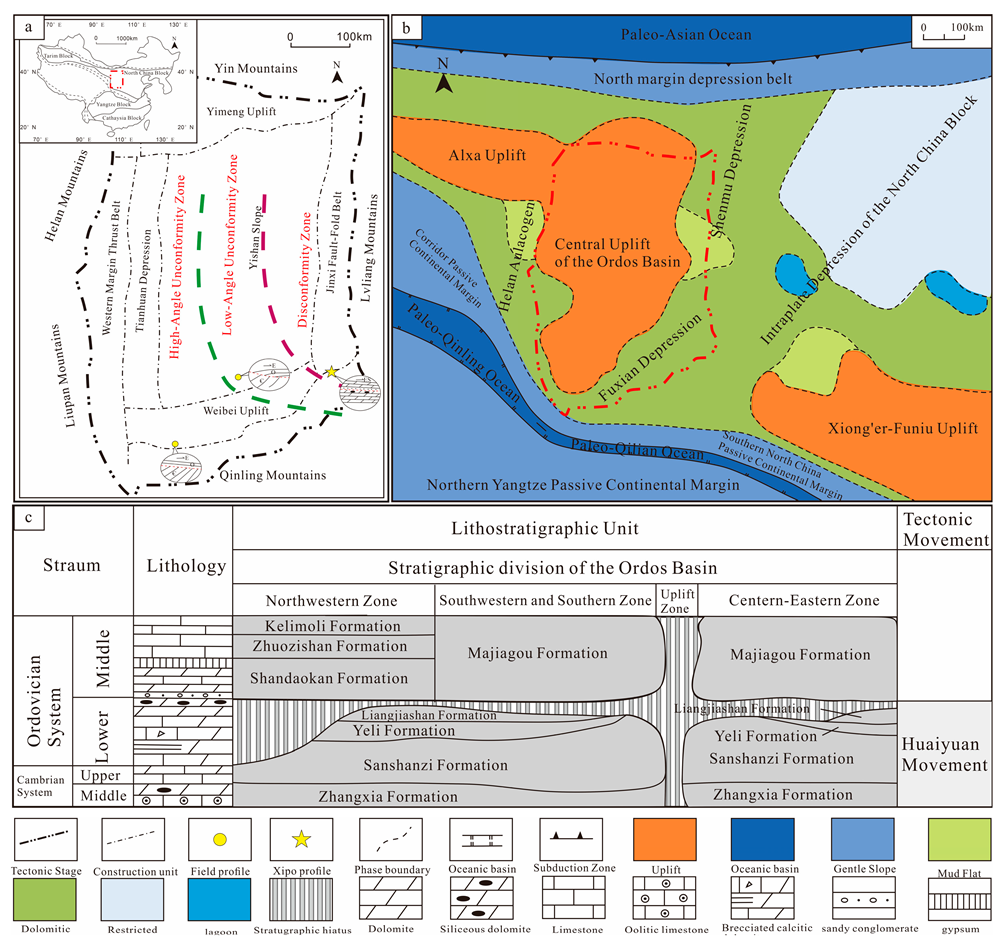
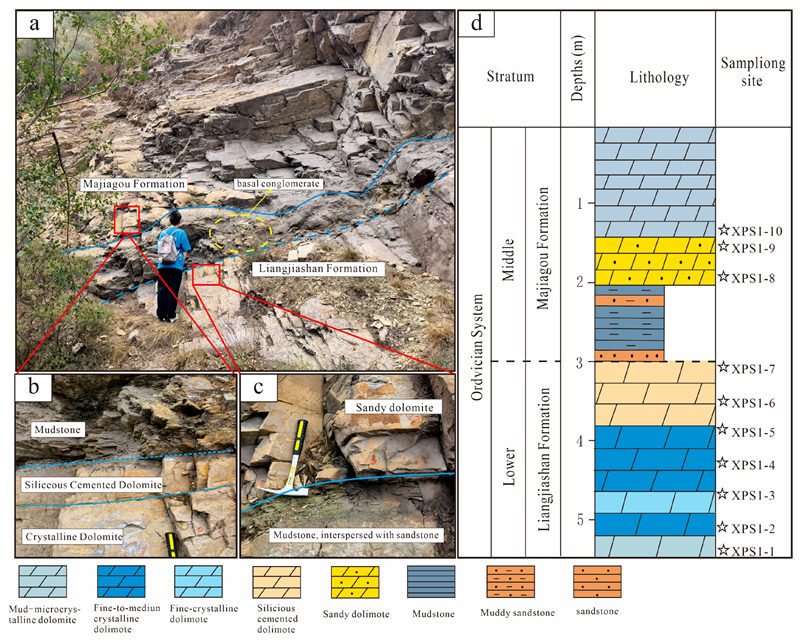
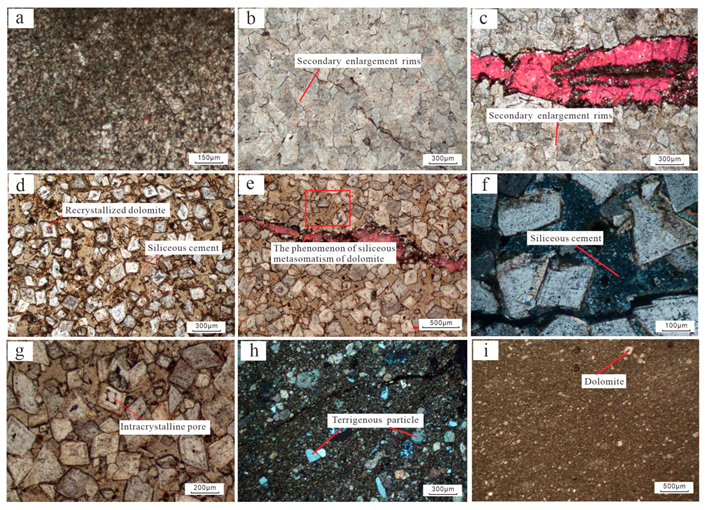
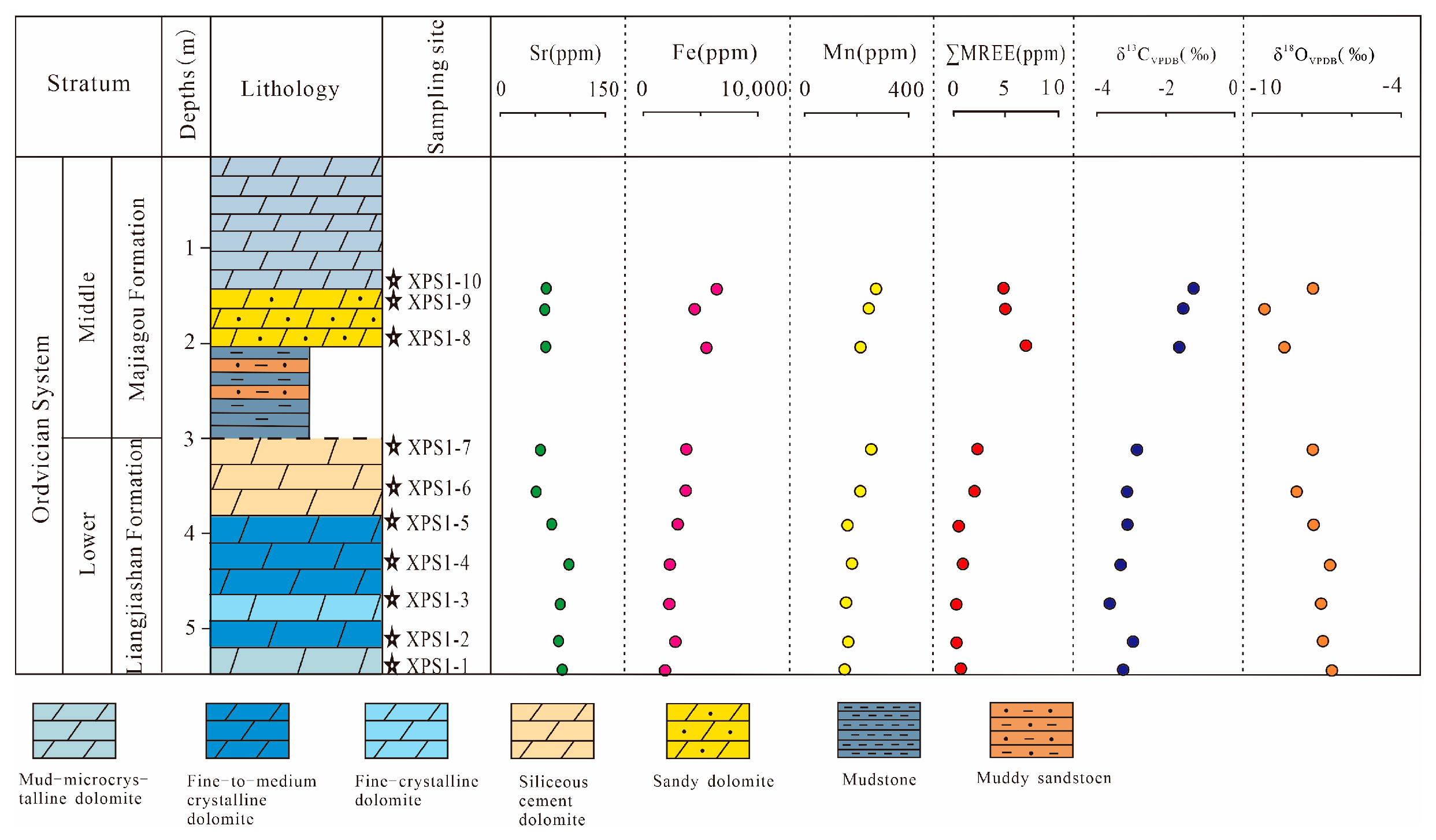

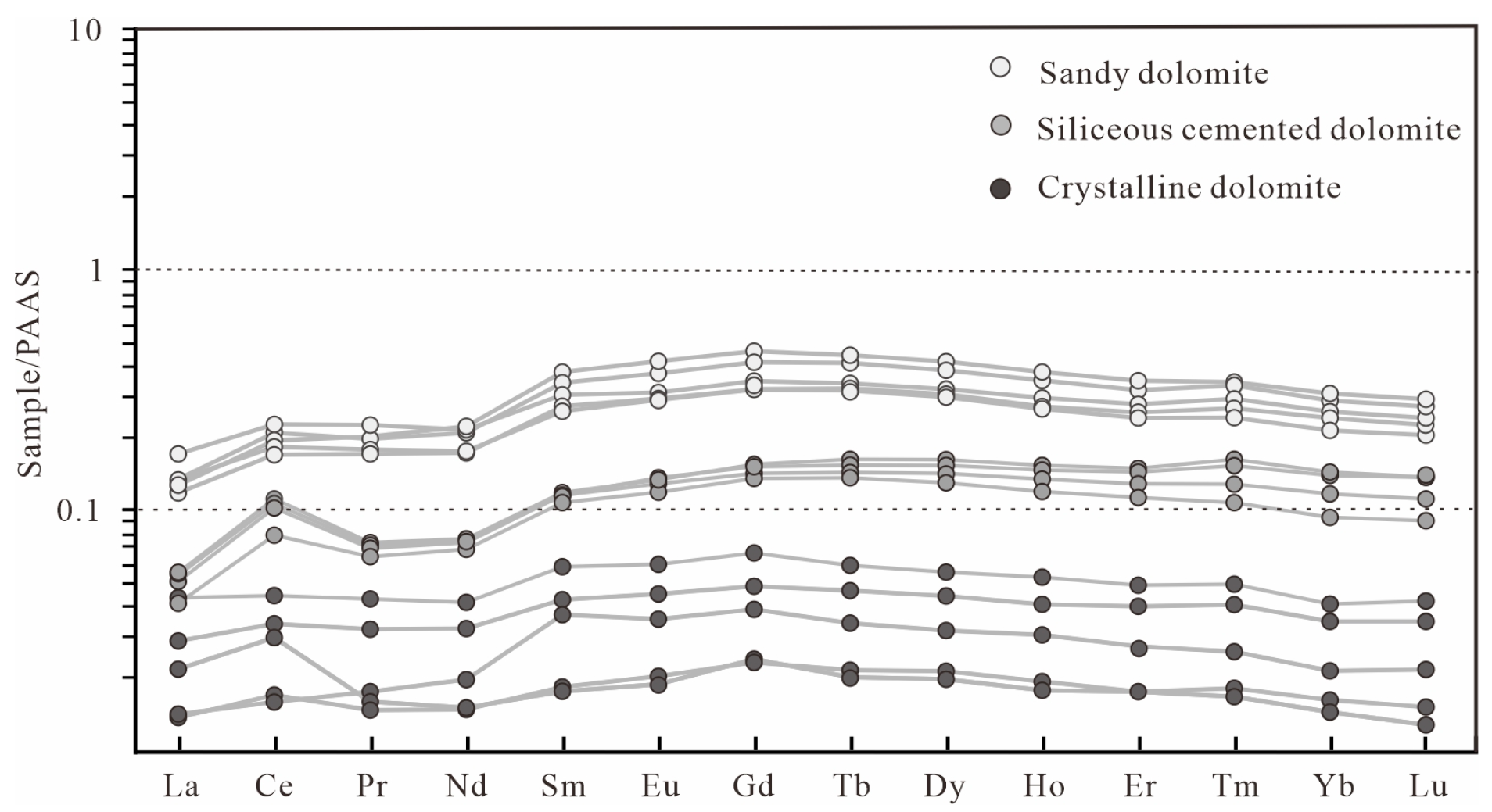
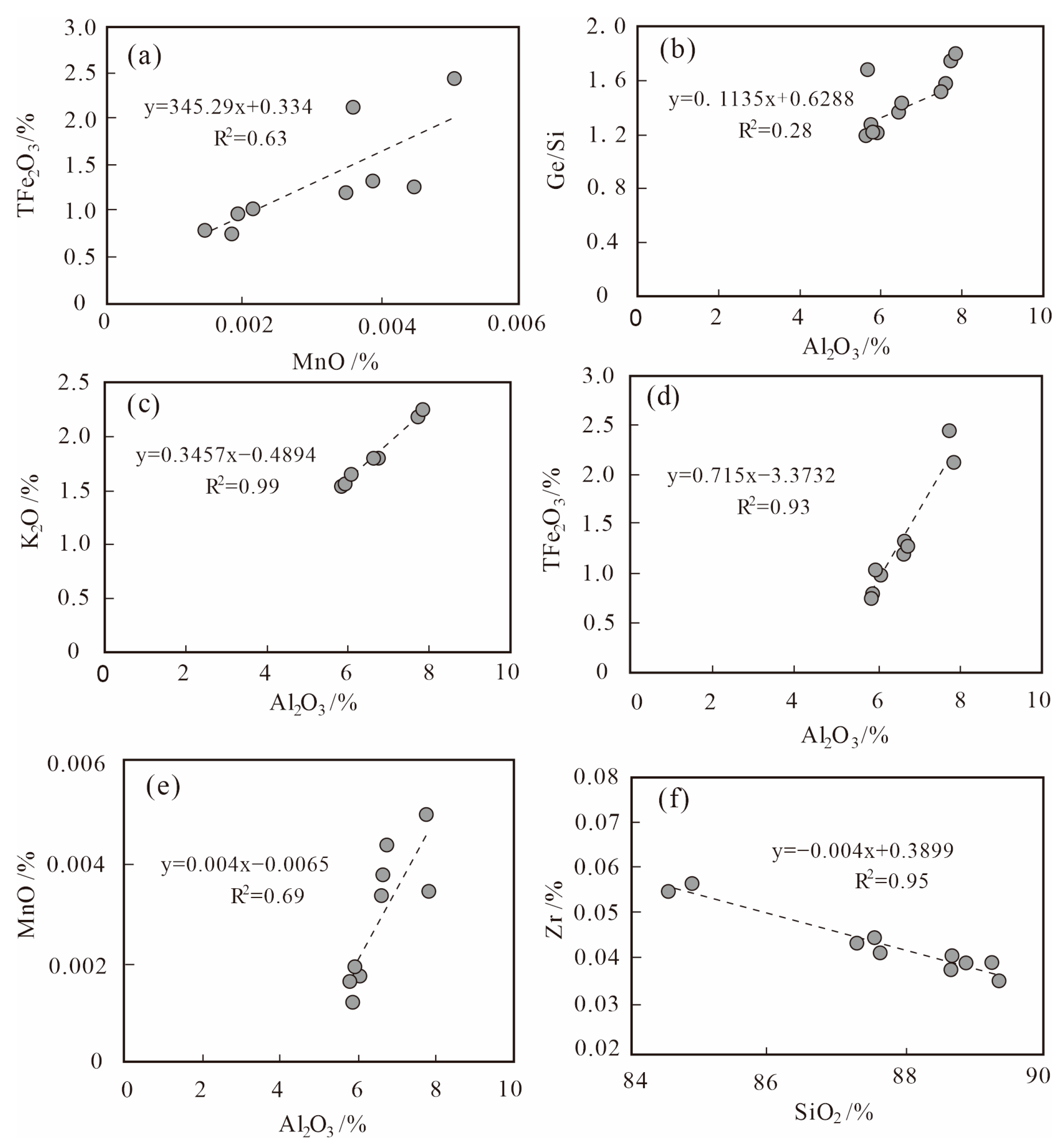
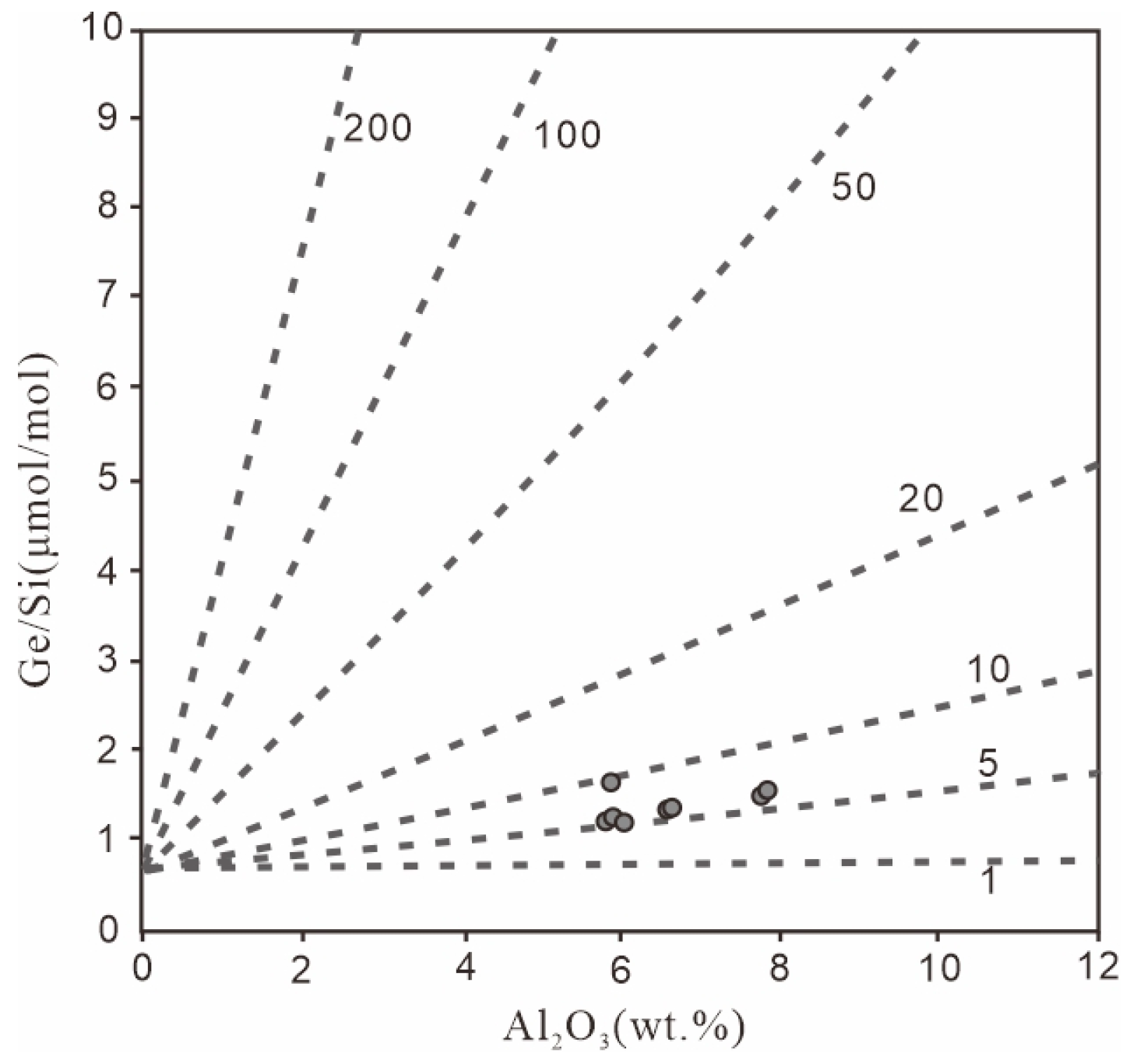
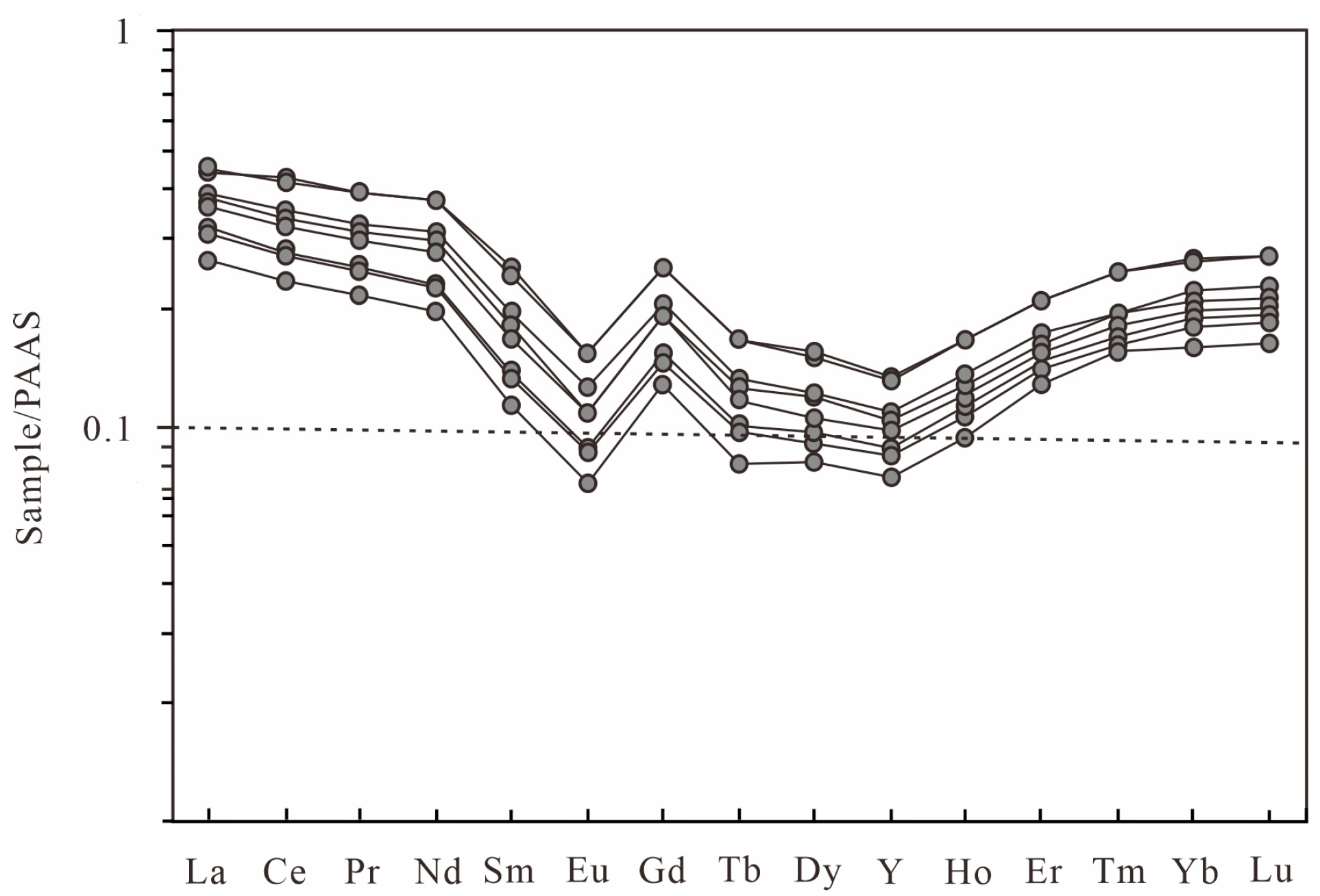
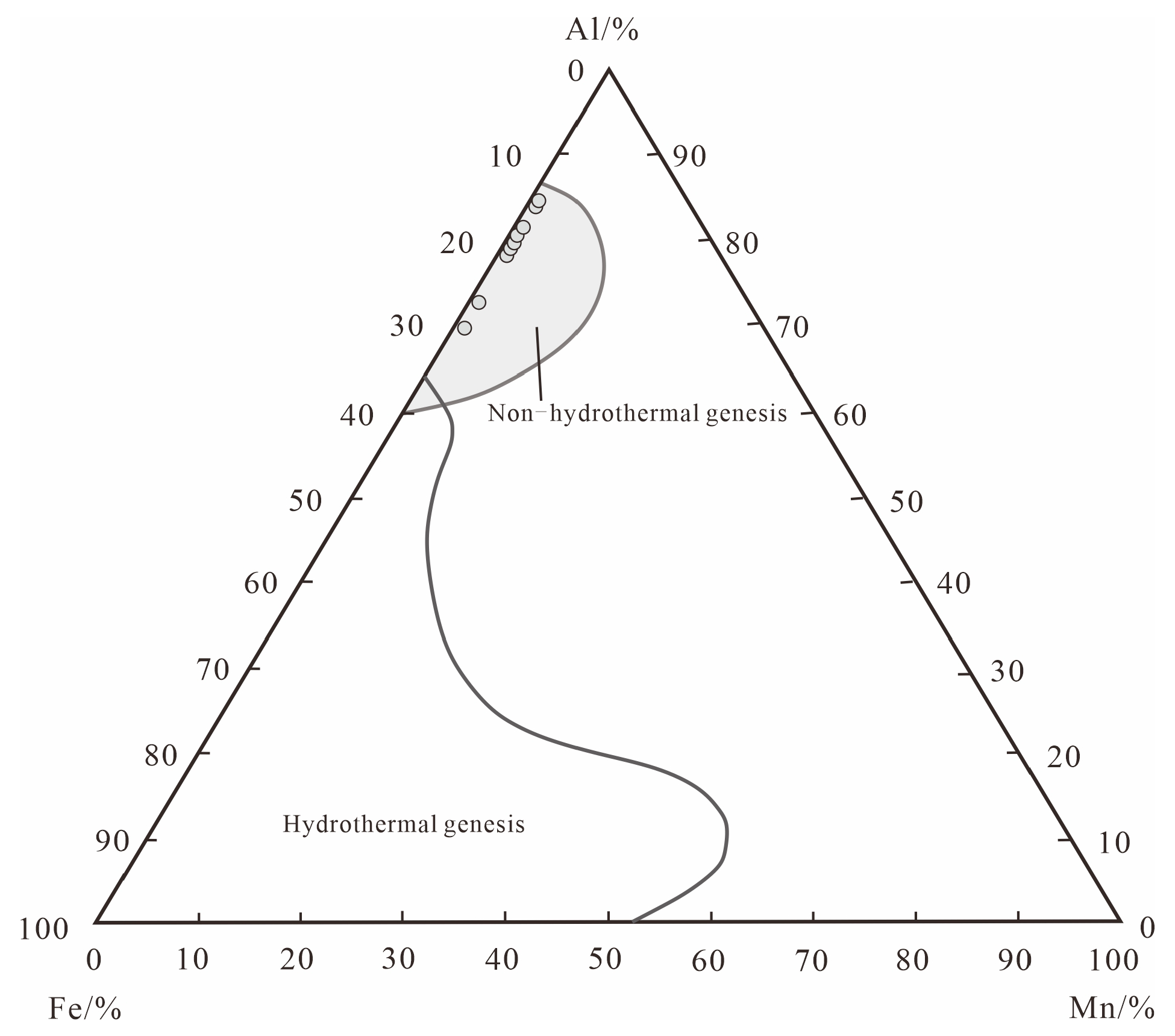
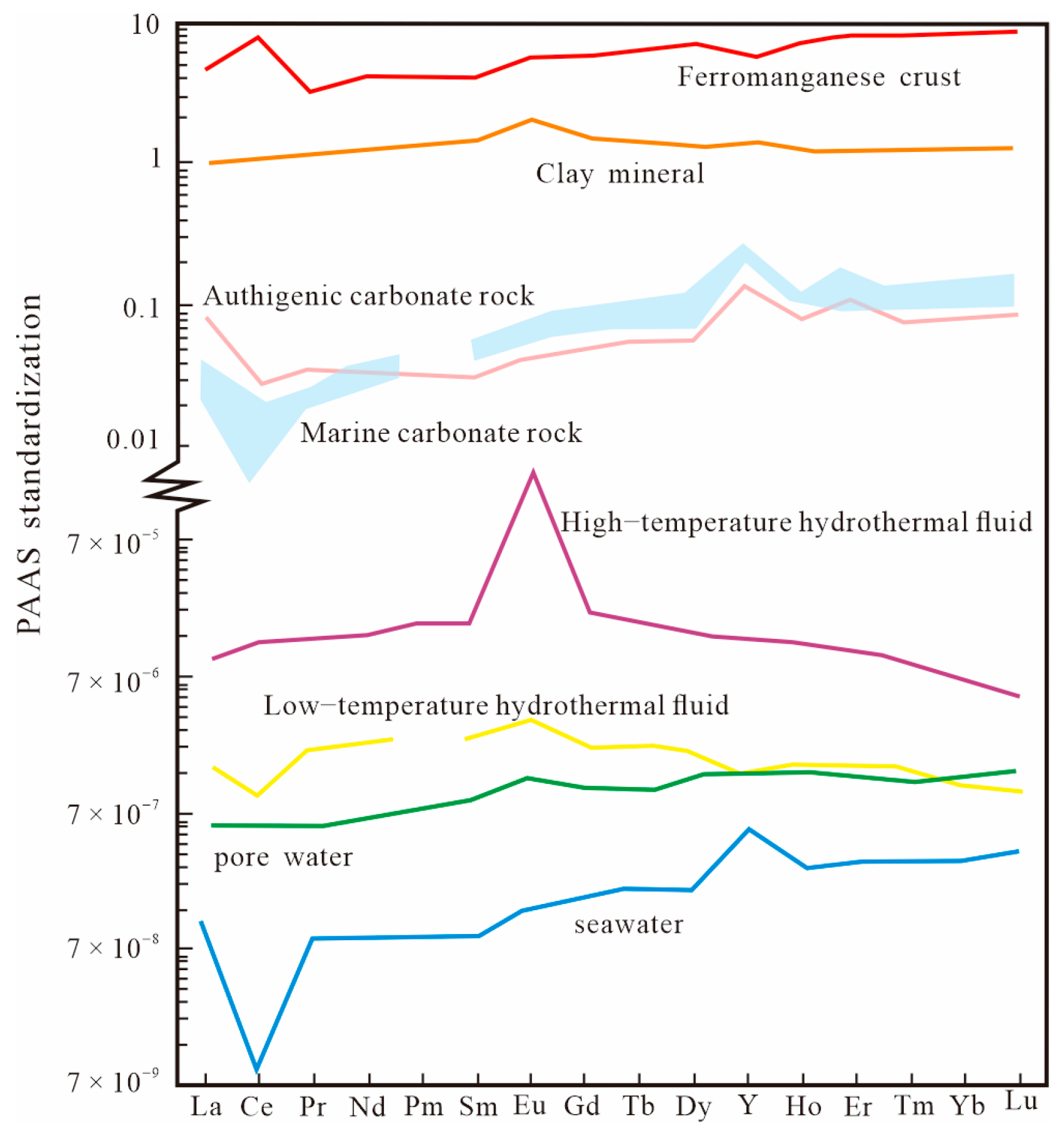
| Sample Number | No. | Stratum | Lithology | Concentration (ppm) | δ13CPDB (‰) | δ18OPDB (‰) | ||||||
|---|---|---|---|---|---|---|---|---|---|---|---|---|
| Mg (ppm) | Al (ppm) | Sr (ppm) | Ca (ppm) | Fe (ppm) | Mn (ppm) | Ba (ppm) | ||||||
| XPS1-1 | S1-1 | Liangjiashan Formation | Mud–Microcrystalline dolomite | 133,897 | 300 | 89 | 230,368 | 1911 | 154 | 2 | −3.26 | −6.80 |
| XPS1-2 | S1-2 | Fine–medium crystalline dolomite | 134,242 | 90 | 83 | 228,109 | 2817 | 168 | 2 | −2.97 | −7.15 | |
| XPS1-3 | S1-3 | Fine crystalline dolomite | 136,968 | 174 | 86 | 230,378 | 2277 | 160 | 2 | −3.64 | −7.22 | |
| XPS1-4 | S1-4 | Fine–medium crystalline dolomite | 130,518 | 190 | 98 | 226,301 | 2329 | 183 | 2 | −3.33 | −6.86 | |
| XPS1-5 | S1-5 | Fine–medium crystalline dolomite | 128,170 | 553 | 74 | 219,602 | 3010 | 165 | 3 | −3.13 | −7.52 | |
| XPS1-6 | S1-6 | Siliceous-cemented dolomite | 87,222 | 1643 | 51 | 154,744 | 3710 | 215 | 7 | −3.14 | −8.21 | |
| S1-7 | Siliceous-cemented dolomite | 90,296 | 1609 | 52 | 159,367 | 3675 | 216 | 5 | −3.18 | −8.20 | ||
| XPS1-7 | S1-8 | Siliceous-cemented dolomite | 105,674 | 805 | 58 | 180,361 | 3752 | 243 | 6 | −2.91 | −7.54 | |
| S1-9 | Siliceous-cemented dolomite | 107,964 | 576 | 60 | 184,499 | 3679 | 256 | 3 | −2.83 | −7.63 | ||
| XPS1-8 | S1-10 | Majiagou Formation | Sandy dolomite | 70,982 | 3194 | 61 | 119,858 | 5604 | 207 | 4 | −1.57 | −8.69 |
| S1-11 | Sandy dolomite | 81,373 | 2856 | 65 | 137,522 | 5518 | 215 | 60 | −1.46 | −9.49 | ||
| XPS1-9 | S1-12 | Sandy dolomite | 87,690 | 7434 | 73 | 151,281 | 6931 | 261 | 57 | −1.12 | −7.61 | |
| S1-13 | Sandy dolomite | 87,131 | 2360 | 64 | 147,010 | 4488 | 249 | 16 | −1.16 | −7.54 | ||
| XPS1-10 | S1-14 | Sandy dolomite | 94,129 | 2936 | 66 | 161,411 | 6327 | 275 | 8 | −1.13 | −7.45 | |
| S1-15 | Sandy dolomite | 92,365 | 6814 | 77 | 160,741 | 6289 | 275 | 5 | −1.20 | −7.60 | ||
| Sample Number | No. | Stratum | W (Rare Earth Elements)/μg/g | ΣREEs | ΣMREE | (Nd/Yb)N | Ce/Ce* | ||||||||||||||
|---|---|---|---|---|---|---|---|---|---|---|---|---|---|---|---|---|---|---|---|---|---|
| La | Ce | Pr | Nd | Sm | Eu | Gd | Tb | Dy | Y | Ho | Er | Tm | Yb | Lu | |||||||
| XPS1-1 | S1-1 | Liangjiashan Formation | 1.09 | 0.83 | 0.52 | 1.65 | 0.54 | 1.63 | 1.56 | 1.92 | 2.04 | 2.09 | 4.83 | 5.13 | 6.51 | 4.48 | 5.09 | 7.30 | 0.75 | 0.94 | 1.11 |
| XPS1-2 | S1-2 | 2.66 | 2.34 | 1.35 | 3.50 | 1.26 | 6.37 | 6.23 | 8.08 | 8.44 | 8.84 | 15.44 | 16.63 | 18.04 | 13.48 | 14.53 | 4.90 | 0.34 | 1.04 | 1.56 | |
| XPS1-3 | S1-3 | 0.28 | 0.14 | 0.13 | 0.38 | 0.15 | 0.58 | 0.56 | 0.61 | 0.63 | 0.64 | 1.78 | 1.74 | 1.99 | 1.51 | 1.57 | 3.54 | 0.35 | 0.91 | 1.20 | |
| XPS1-4 | S1-4 | 1.09 | 0.51 | 0.50 | 1.39 | 0.67 | 2.44 | 2.32 | 2.48 | 2.50 | 2.57 | 7.54 | 7.08 | 7.29 | 5.85 | 5.94 | 9.78 | 0.99 | 1.02 | 1.03 | |
| XPS1-5 | S1-5 | 0.23 | 0.10 | 0.10 | 0.32 | 0.20 | 0.62 | 0.59 | 0.64 | 0.64 | 0.65 | 2.08 | 1.87 | 1.67 | 1.50 | 1.43 | 4.24 | 0.59 | 0.92 | 1.00 | |
| XPS1-6 | S1-6 | 0.05 | 0.02 | 0.02 | 0.06 | 0.04 | 0.13 | 0.13 | 0.14 | 0.15 | 0.14 | 0.45 | 0.40 | 0.33 | 0.31 | 0.31 | 17.58 | 2.12 | 0.76 | 1.48 | |
| S1-7 | 0.22 | 0.11 | 0.11 | 0.31 | 0.18 | 0.65 | 0.63 | 0.66 | 0.70 | 0.72 | 2.13 | 1.92 | 1.60 | 1.48 | 1.47 | 16.99 | 2.06 | 0.74 | 1.50 | ||
| XPS1-7 | S1-8 | 0.04 | 0.02 | 0.02 | 0.05 | 0.03 | 0.11 | 0.10 | 0.11 | 0.12 | 0.12 | 0.34 | 0.31 | 0.26 | 0.25 | 0.24 | 20.14 | 2.21 | 0.63 | 1.70 | |
| S1-9 | 1.15 | 0.63 | 0.56 | 1.53 | 0.84 | 3.66 | 3.47 | 3.91 | 4.36 | 4.30 | 9.89 | 9.76 | 7.54 | 7.32 | 7.55 | 21.93 | 2.40 | 0.53 | 1.74 | ||
| XPS1-8 | S1-10 | Majiagou Formation | 0.04 | 0.02 | 0.02 | 0.05 | 0.03 | 0.12 | 0.12 | 0.13 | 0.14 | 0.15 | 0.37 | 0.34 | 0.29 | 0.27 | 0.26 | 48.87 | 6.92 | 0.73 | 1.18 |
| S1-11 | 0.11 | 0.05 | 0.05 | 0.14 | 0.08 | 0.32 | 0.32 | 0.37 | 0.41 | 0.42 | 0.98 | 0.90 | 0.78 | 0.72 | 0.69 | 48.92 | 6.29 | 0.73 | 1.26 | ||
| XPS1-9 | S1-12 | 0.02 | 0.01 | 0.01 | 0.02 | 0.01 | 0.04 | 0.04 | 0.05 | 0.06 | 0.06 | 0.14 | 0.13 | 0.12 | 0.11 | 0.10 | 48.72 | 5.35 | 0.84 | 1.15 | |
| S1-13 | 0.10 | 0.04 | 0.05 | 0.11 | 0.06 | 0.27 | 0.26 | 0.33 | 0.39 | 0.41 | 0.86 | 0.80 | 0.72 | 0.68 | 0.60 | 39.46 | 4.95 | 0.72 | 1.18 | ||
| XPS1-10 | S1-14 | 0.01 | 0.01 | 0.01 | 0.02 | 0.01 | 0.04 | 0.04 | 0.05 | 0.06 | 0.06 | 0.12 | 0.12 | 0.10 | 0.10 | 0.09 | 41.25 | 4.83 | 0.82 | 1.17 | |
| S1-15 | 1.09 | 0.83 | 0.52 | 1.65 | 0.54 | 1.63 | 1.56 | 1.92 | 2.04 | 2.09 | 4.83 | 5.13 | 6.51 | 4.48 | 5.09 | 49.29 | 5.26 | 0.96 | 1.12 | ||
| No. | Major Element Content (%) | Zr/% | Ge/ (μg/g) | (Ge/Si)/ (μmol/mol) | |||||||
|---|---|---|---|---|---|---|---|---|---|---|---|
| Al2O3 | TFe2O3 | K2O | MgO | CaO | MnO | Na2O | SiO2 | ||||
| XPS1-6-1 | 5.88 | 0.80 | 1.54 | 0.65 | 0.072 | 0.0012 | 0.12 | 89.45 | 0.035 | 1.83 | 1.66 |
| XPS1-6-2 | 6.08 | 0.98 | 1.65 | 0.68 | 0.079 | 0.0017 | 0.12 | 88.76 | 0.038 | 1.32 | 1.20 |
| XPS1-6-3 | 5.94 | 1.03 | 1.55 | 0.67 | 0.086 | 0.0019 | 0.12 | 88.75 | 0.040 | 1.32 | 1.21 |
| XPS1-6-4 | 5.83 | 0.75 | 1.55 | 0.65 | 0.083 | 0.0016 | 0.12 | 89.35 | 0.039 | 1.31 | 1.19 |
| XPS1-6-5 | 5.94 | 1.03 | 1.56 | 0.67 | 0.083 | 0.0019 | 0.12 | 88.97 | 0.039 | 1.39 | 1.27 |
| XPS1-7 | 7.85 | 2.14 | 2.25 | 0.89 | 0.088 | 0.0034 | 0.12 | 84.93 | 0.056 | 1.63 | 1.56 |
| XPS1-7-2 | 7.76 | 2.44 | 2.19 | 0.90 | 0.086 | 0.0049 | 0.12 | 84.56 | 0.055 | 1.56 | 1.50 |
| XPS1-7-3 | 6.64 | 1.20 | 1.79 | 0.74 | 0.077 | 0.0033 | 0.12 | 87.69 | 0.041 | 1.47 | 1.36 |
| XPS1-7-4 | 6.65 | 1.33 | 1.81 | 0.75 | 0.086 | 0.0037 | 0.12 | 87.34 | 0.043 | 1.45 | 1.35 |
| XPS1-7-5 | 6.74 | 1.28 | 1.80 | 0.75 | 0.074 | 0.0043 | 0.12 | 87.61 | 0.044 | 1.53 | 1.42 |
| No. | W (Rare Earth Elements)/μg/g | ΣREEs | Eu/Eu* | Ce/Ce* | ||||||||||||||
|---|---|---|---|---|---|---|---|---|---|---|---|---|---|---|---|---|---|---|
| La | Ce | Pr | Nd | Sm | Eu | Gd | Tb | Dy | Y | Ho | Er | Tm | Yb | Lu | ||||
| XPS1-6 | 0.27 | 0.24 | 0.22 | 0.20 | 0.11 | 0.07 | 0.13 | 0.08 | 0.08 | 0.07 | 0.09 | 0.13 | 0.16 | 0.16 | 0.16 | 44.32 | 0.60 | 0.98 |
| XPS1-6-2 | 0.31 | 0.28 | 0.25 | 0.23 | 0.14 | 0.09 | 0.15 | 0.10 | 0.10 | 0.09 | 0.11 | 0.14 | 0.18 | 0.19 | 0.19 | 51.59 | 0.62 | 0.99 |
| XPS1-6-3 | 0.32 | 0.28 | 0.26 | 0.23 | 0.14 | 0.09 | 0.15 | 0.10 | 0.10 | 0.09 | 0.11 | 0.15 | 0.17 | 0.19 | 0.19 | 52.97 | 0.62 | 0.98 |
| XPS1-6-4 | 0.30 | 0.27 | 0.25 | 0.22 | 0.13 | 0.09 | 0.14 | 0.10 | 0.09 | 0.09 | 0.11 | 0.14 | 0.16 | 0.18 | 0.19 | 50.73 | 0.63 | 0.98 |
| XPS1-6-5 | 0.31 | 0.28 | 0.25 | 0.23 | 0.14 | 0.09 | 0.15 | 0.10 | 0.10 | 0.09 | 0.11 | 0.14 | 0.17 | 0.19 | 0.19 | 51.67 | 0.61 | 0.99 |
| XPS1-7 | 0.46 | 0.43 | 0.40 | 0.38 | 0.25 | 0.15 | 0.25 | 0.16 | 0.15 | 0.13 | 0.16 | 0.21 | 0.25 | 0.27 | 0.27 | 80.34 | 0.62 | 1.00 |
| XPS1-7-2 | 0.45 | 0.42 | 0.40 | 0.38 | 0.26 | 0.15 | 0.25 | 0.17 | 0.16 | 0.14 | 0.17 | 0.21 | 0.25 | 0.26 | 0.27 | 79.52 | 0.60 | 1.00 |
| XPS1-7-3 | 0.36 | 0.33 | 0.30 | 0.28 | 0.17 | 0.11 | 0.19 | 0.12 | 0.11 | 0.10 | 0.12 | 0.16 | 0.18 | 0.20 | 0.20 | 60.66 | 0.60 | 0.99 |
| XPS1-7-4 | 0.38 | 0.34 | 0.32 | 0.30 | 0.18 | 0.11 | 0.19 | 0.13 | 0.12 | 0.11 | 0.13 | 0.16 | 0.20 | 0.21 | 0.21 | 64.48 | 0.59 | 0.99 |
| XPS1-7-5 | 0.39 | 0.36 | 0.33 | 0.31 | 0.20 | 0.13 | 0.20 | 0.13 | 0.12 | 0.11 | 0.14 | 0.17 | 0.20 | 0.22 | 0.23 | 66.87 | 0.63 | 1.00 |
Disclaimer/Publisher’s Note: The statements, opinions and data contained in all publications are solely those of the individual author(s) and contributor(s) and not of MDPI and/or the editor(s). MDPI and/or the editor(s) disclaim responsibility for any injury to people or property resulting from any ideas, methods, instructions or products referred to in the content. |
© 2025 by the authors. Licensee MDPI, Basel, Switzerland. This article is an open access article distributed under the terms and conditions of the Creative Commons Attribution (CC BY) license (https://creativecommons.org/licenses/by/4.0/).
Share and Cite
Quan, H.; Yu, Z.; Qiao, Z.; Li, C.; Xia, P.; Su, Z.; Wen, H.; Qin, M.; Ning, M. Sedimentary and Early Diagenetic Responses to the Huaiyuan Movement During the Early–Middle Ordovician Transition in the Ordos Basin, North China. Geosciences 2025, 15, 219. https://doi.org/10.3390/geosciences15060219
Quan H, Yu Z, Qiao Z, Li C, Xia P, Su Z, Wen H, Qin M, Ning M. Sedimentary and Early Diagenetic Responses to the Huaiyuan Movement During the Early–Middle Ordovician Transition in the Ordos Basin, North China. Geosciences. 2025; 15(6):219. https://doi.org/10.3390/geosciences15060219
Chicago/Turabian StyleQuan, Hao, Zhou Yu, Zhanfeng Qiao, Chenqing Li, Pan Xia, Zhongtang Su, Huaguo Wen, Min Qin, and Meng Ning. 2025. "Sedimentary and Early Diagenetic Responses to the Huaiyuan Movement During the Early–Middle Ordovician Transition in the Ordos Basin, North China" Geosciences 15, no. 6: 219. https://doi.org/10.3390/geosciences15060219
APA StyleQuan, H., Yu, Z., Qiao, Z., Li, C., Xia, P., Su, Z., Wen, H., Qin, M., & Ning, M. (2025). Sedimentary and Early Diagenetic Responses to the Huaiyuan Movement During the Early–Middle Ordovician Transition in the Ordos Basin, North China. Geosciences, 15(6), 219. https://doi.org/10.3390/geosciences15060219







